Modeling the Effects of Different Water and Fertilizer Irrigation Systems on Greenhouse Gas Emissions Using the DNDC Model
Abstract
1. Introduction
2. Materials and Methods
2.1. Study Area
2.2. Experimental Design
2.3. Method
2.3.1. Determination of Total N2O and CO2 Emissions from Farmland
2.3.2. Determination of Summer Maize Yield
2.4. DNDC Model
2.4.1. Model Parameter Input
2.4.2. Model Evaluation
3. Results
3.1. Effects of Different Water and Fertilizer Irrigation Systems on Yields
3.2. Effects of Different Water and Fertilizer Irrigation Systems on Total N2O Emissions from Farmland
3.3. Effects of Different Water and Fertilizer Irrigation Systems on Total CO2 Emissions from Farmland
3.4. Model Verification
3.4.1. Validation of DNDC Model on Summer Maize Yield
3.4.2. Validation of DNDC Model on N2O Emissions
3.4.3. Validation of DNDC Model on CO2 Emissions
3.5. DNDC Model Simulation
4. Discussion
4.1. Research Limitations and Future Work
4.1.1. Planting Date
4.1.2. Tillage Measures
4.1.3. Cover Crops
4.1.4. Future Work
5. Conclusions
- (1)
- Irrigation and fertilization significantly affected the summer maize yields, total N2O emissions, and total CO2 emissions under the real-time irrigation system, and there was a significant interaction between them.
- (2)
- The field-measured data of the summer maize yields verified the DNDC model. The results showed that the simulated values of the summer maize yields and total N2O and CO2 emissions from farmland with different water and fertilizer treatments under the real-time irrigation system were highly consistent with the measured values, indicating that the DNDC model can simulate summer maize yields and total greenhouse gas emissions from dryland farmland. The application of the model to evaluate greenhouse gas emissions from dryland farmland has certain reliability.
- (3)
- Under the simulated scenario, the summer maize yields under the real-time irrigation system in 2023 and 2024 increased by 4.43% and 4.38% compared with those under full irrigation. In addition, the total N2O emissions from farmland were reduced by 6.56% and 6.22%, respectively, compared with full irrigation, while the total CO2 emissions from farmland were 14.49% and 14.79% lower than those of full irrigation, indicating that the real-time irrigation system saved water, increased yields, and reduced greenhouse gas emissions from farmland.
Supplementary Materials
Author Contributions
Funding
Conflicts of Interest
References
- Bennetzen, E.H.; Smith, P.; Porter, J.R. Agricultural Production and Greenhouse Gas Emissions from World Regions—The Major Trends over 40 Years. Glob. Environ. Chang. 2016, 37, 43–55. [Google Scholar] [CrossRef]
- Zhang, J.; Guo, Y.; Han, J.; Ji, Y.; Zhang, L. Greenhouse Gas Emissions and Net Global Warming Potential of Vineyards under Different Fertilizer and Water Managements in North China. Agric. Water Manag. 2021, 243, 106521. [Google Scholar] [CrossRef]
- Wang, J.; Hussain, S.; Sun, X.; Chen, X.; Ma, Z.; Zhang, Q.; Yu, X.; Zhang, P.; Ren, X.; Saqib, M.; et al. Nitrogen Application at a Lower Rate Reduce Net Field Global Warming Potential and Greenhouse Gas Intensity in Winter Wheat Grown in Semi-Arid Region of the Loess Plateau. Field Crops Res. 2022, 280, 108475. [Google Scholar] [CrossRef]
- Hamad, A.A.; Wei, Q.; Xu, J.; Hamoud, Y.A.; He, M.; Shaghaleh, H.; Wei, Q.; Li, X.; Qi, Z. Managing Fertigation Frequency and Level to Mitigate N2O and CO2 Emissions and NH3 Volatilization from Subsurface Drip-Fertigated Field in a Greenhouse. Agronomy 2022, 12, 1414. [Google Scholar] [CrossRef]
- Liu, T.Q.; Li, S.H.; Guo, L.G.; Cao, C.G.; Li, C.F.; Zhai, Z.B.; Zhou, J.Y.; Mei, Y.M.; Ke, H.J. Advantages of Nitrogen Fertilizer Deep Placement in Greenhouse Gas Emissions and Net Ecosystem Economic Benefits from No-Tillage Paddy Fields. J. Clean. Prod. 2020, 263, 121322. [Google Scholar] [CrossRef]
- Zhang, G.; Huang, Q.; Song, K.; Yu, H.; Ma, J.; Xu, H. Responses of Greenhouse Gas Emissions and Soil Carbon and Nitrogen Sequestration to Field Management in the Winter Season: A 6-Year Measurement in a Chinese Double-Rice Field. Agric. Ecosyst. Environ. 2021, 318, 107506. [Google Scholar] [CrossRef]
- Zhang, F.; Liu, F.; Ma, X.; Guo, G.; Liu, B.; Cheng, T.; Liang, T.; Tao, W.; Chen, X.; Wang, X. Greenhouse Gas Emissions from Vegetables Production in China. J. Clean. Prod. 2021, 317, 128449. [Google Scholar] [CrossRef]
- Liang, T.; Liao, D.; Wang, S.; Yang, B.; Zhao, J.; Zhu, C.; Tao, Z.; Shi, X.; Chen, X.; Wang, X. The Nitrogen and Carbon Footprints of Vegetable Production in the Subtropical High Elevation Mountain Region. Ecol. Indic. 2021, 122, 107298. [Google Scholar] [CrossRef]
- Huang, Q.; Zhang, G.; Ma, J.; Song, K.; Zhu, X.; Shen, W.; Xu, H. Dynamic Interactions of Nitrogen Fertilizer and Straw Application on Greenhouse Gas Emissions and Sequestration of Soil Carbon and Nitrogen: A 13-Year Field Study. Agric. Ecosyst. Environ. 2022, 325, 107753. [Google Scholar] [CrossRef]
- Guo, L.; Zhao, S.; Song, Y.; Tang, M.; Li, H. Green Finance, Chemical Fertilizer Use and Carbon Emissions from Agricultural Production. Agriculture 2022, 12, 313. [Google Scholar] [CrossRef]
- Cui, H.; Wang, Y.; Luo, Y.; Jin, M.; Chen, J.; Pang, D.; Li, Y.; Wang, Z. Tillage Strategies Optimize SOC Distribution to Reduce Carbon Footprint. Soil Tillage Res. 2022, 223, 105499. [Google Scholar] [CrossRef]
- Wang, H.; Wang, S.; Yu, Q.; Zhang, Y.; Wang, R.; Li, J.; Wang, X. No Tillage Increases Soil Organic Carbon Storage and Decreases Carbon Dioxide Emission in the Crop Residue-Returned Farming System. J. Environ. Manag. 2020, 261, 110261. [Google Scholar] [CrossRef] [PubMed]
- Guo, Z.; Liu, Y.; Meng, X.; Yang, X.; Ma, C.; Chai, H.; Li, H.; Ding, R.; Nazarov, K.; Zhang, X.; et al. The Long-Term Nitrogen Fertilizer Management Strategy Based on Straw Return Can Improve the Productivity of Wheat-Maize Rotation System and Reduce Carbon Emissions by Increasing Soil Carbon and Nitrogen Sequestration. Field Crops Res. 2024, 317, 109561. [Google Scholar] [CrossRef]
- Li, J.; Li, Y.; Lin, N.; Fang, Y.; Dong, Q.; Zhang, T.; Siddique, K.H.M.; Wang, N.; Feng, H. Ammoniated Straw Returning: A Win-Win Strategy for Increasing Crop Production and Soil Carbon Sequestration. Agric. Ecosyst. Environ. 2024, 363, 108879. [Google Scholar] [CrossRef]
- Chen, X.; Xie, Y.; Wang, J.; Shi, Z.; Zhang, J.; Wei, H.; Ma, Y. Presence of Different Microplastics Promotes Greenhouse Gas Emissions and Alters the Microbial Community Composition of Farmland Soil. Sci. Total Environ. 2023, 879, 162967. [Google Scholar] [CrossRef]
- Ni, B.; Zhang, W.; Xu, X.; Wang, L.; Bol, R.; Wang, K.; Hu, Z.; Zhang, H.; Meng, F. Exponential Relationship between N2O Emission and Fertilizer Nitrogen Input and Mechanisms for Improving Fertilizer Nitrogen Efficiency under Intensive Plastic-Shed Vegetable Production in China: A Systematic Analysis. Agric. Ecosyst. Environ. 2021, 312, 107353. [Google Scholar] [CrossRef]
- Wang, Y.Y.; Hu, C.S.; Ming, H.; Zhang, Y.M.; Li, X.X.; Dong, W.X.; Oenema, O. Concentration Profiles of CH4, CO2 and N2O in Soils of a Wheat-Maize Rotation Ecosystem in North China Plain, Measured Weekly over a Whole Year. Agric. Ecosyst. Environ. 2013, 164, 260–272. [Google Scholar] [CrossRef]
- Xu, P.; Li, Z.; Wang, J.; Zou, J. Fertilizer-Induced Nitrous Oxide Emissions from Global Orchards and Its Estimate of China. Agric. Ecosyst. Environ. 2022, 328, 107854. [Google Scholar] [CrossRef]
- Ardenti, F.; Abalos, D.; Capra, F.; Lommi, M.; Maris, S.C.; Perego, A.; Bertora, C.; Tabaglio, V.; Fiorini, A. Matching Crop Row and Dripline Distance in Subsurface Drip Irrigation Increases Yield and Mitigates N2O Emissions. Field Crops Res. 2022, 289, 108732. [Google Scholar] [CrossRef]
- Wang, H.; Wang, N.; Quan, H.; Zhang, F.; Fan, J.; Feng, H.; Cheng, M.; Liao, Z.; Wang, X.; Xiang, Y. Yield and Water Productivity of Crops, Vegetables and Fruits under Subsurface Drip Irrigation: A Global Meta-Analysis. Agric. Water Manag. 2022, 269, 107645. [Google Scholar] [CrossRef]
- Abdalla, M.; Song, X.; Ju, X.; Topp, C.F.E.; Smith, P. Calibration and Validation of the DNDC Model to Estimate Nitrous Oxide Emissions and Crop Productivity for a Summer Maize-Winter Wheat Double Cropping System in Hebei, China. Environ. Pollut. 2020, 262, 114199. [Google Scholar] [CrossRef]
- Tian, Z.; Fan, Y.; Wang, K.; Zhong, H.; Sun, L.; Fan, D.; Tubiello, F.N.; Liu, J. Searching for “Win-Win” Solutions for Food-Water-GHG Emissions Tradeoffs across Irrigation Regimes of Paddy Rice in China. Resour. Conserv. Recycl. 2021, 166, 105360. [Google Scholar] [CrossRef]
- Grant, F.; Sheline, C.; Sokol, J.; Amrose, S.; Brownell, E.; Nangia, V.; Winter, A.G. Creating a Solar-Powered Drip Irrigation Optimal Performance Model (SDrOP) to Lower the Cost of Drip Irrigation Systems for Smallholder Farmers. Appl. Energy 2022, 323, 119563. [Google Scholar] [CrossRef]
- Alderman, P.D. A Comprehensive R Interface for the DSSAT Cropping Systems Model. Comput. Electron. Agric. 2020, 172, 105325. [Google Scholar] [CrossRef]
- Chapagain, R.; Huth, N.; Remenyi, T.A.; Mohammed, C.L.; Ojeda, J.J. Assessing the Effect of Using Different APSIM Model Configurations on Model Outputs. Ecol. Model. 2023, 483, 110451. [Google Scholar] [CrossRef]
- Ntakos, G.; Prikaziuk, E.; ten Den, T.; Reidsma, P.; Vilfan, N.; van der Wal, T.; van der Tol, C. Coupled WOFOST and SCOPE Model for Remote Sensing-Based Crop Growth Simulations. Comput. Electron. Agric. 2024, 225, 109238. [Google Scholar] [CrossRef]
- Chang, N.; Chen, D.; Cai, Y.; Li, J.; Zhang, M.; Li, H.; Wang, L. Enhancing Crop Yield and Carbon Sequestration and Greenhouse Gas Emission Mitigation through Different Organic Matter Input in the Bohai Rim Region: An Estimation Based on the DNDC-RF Framework. Field Crops Res. 2024, 319, 109624. [Google Scholar] [CrossRef]
- Zhang, Y.; Yu, Q. Does Agroecosystem Model Improvement Increase Simulation Accuracy for Agricultural N2O Emissions? Agric. For. Meteorol. 2021, 297, 108281. [Google Scholar] [CrossRef]
- Zhao, Z.; Cao, L.; Deng, J.; Sha, Z.; Chu, C.; Zhou, D.; Wu, S.; Lv, W. Modeling CH4 and N2O Emission Patterns and Mitigation Potential from Paddy Fields in Shanghai, China with the DNDC Model. Agric. Syst. 2020, 178, 102743. [Google Scholar] [CrossRef]
- Yao, Y.; Li, G.; Lu, Y.; Liu, S. Modelling the Impact of Climate Change and Tillage Practices on Soil CO2 Emissions from Dry Farmland in the Loess Plateau of China. Ecol. Model. 2023, 478, 110276. [Google Scholar] [CrossRef]
- Cao, S.; Liu, X.; Er, H. Dujiangyan Irrigation System—A World Cultural Heritage Corresponding to Concepts of Modern Hydraulic Science. J. Hydro-Environ. Res. 2010, 4, 3–13. [Google Scholar] [CrossRef]
- Li, C.; Frolking, S.; Frolking, T.A. A model of nitrous oxide evolution from soil driven by rainfall events: 2. Model applications. J. Geophys. Res. 1992, 97, 9777–9783. [Google Scholar] [CrossRef]
- Pareja-Sánchez, E.; Cantero-Martínez, C.; Álvaro-Fuentes, J.; Plaza-Bonilla, D. Impact of Tillage and N Fertilization Rate on Soil N2O Emissions in Irrigated Maize in a Mediterranean Agroecosystem. Agric. Ecosyst. Environ. 2020, 287, 106687. [Google Scholar] [CrossRef]
- Yao, X.; Zhang, Z.; Li, K.; Yuan, F.; Xu, X.; Long, X.; Song, C. Optimizing Water and Nitrogen Management to Balance Greenhouse Gas Emissions and Yield in Chinese Rice Paddies. Field Crops Res. 2024, 319, 109621. [Google Scholar] [CrossRef]
- Xiao, C.; Zhang, F.; Li, Y.; Fan, J.; Ji, Q.; Jiang, F.; He, Z. Optimizing Drip Irrigation and Nitrogen Fertilization Regimes to Reduce Greenhouse Gas Emissions, Increase Net Ecosystem Carbon Budget and Reduce Carbon Footprint in Saline Cotton Fields. Agric. Ecosyst. Environ. 2024, 366, 108912. [Google Scholar] [CrossRef]
- Li, W.; Xie, L.; Zhao, C.; Hu, X.; Yin, C. Nitrogen Fertilization Increases Soil Microbial Biomass and Alters Microbial Composition Especially Under Low Soil Water Availability. Microb. Ecol. 2023, 86, 536–548. [Google Scholar] [CrossRef]
- Bahrulolum, H.; Nooraei, S.; Javanshir, N.; Tarrahimofrad, H.; Mirbagheri, V.S.; Easton, A.J.; Ahmadian, G. Green Synthesis of Metal Nanoparticles Using Microorganisms and Their Application in the Agrifood Sector. J. Nanobiotechnol. 2021, 19, 86. [Google Scholar] [CrossRef]
- Tyagi, J.; Ahmad, S.; Malik, M. Nitrogenous Fertilizers: Impact on Environment Sustainability, Mitigation Strategies, and Challenges. Int. J. Environ. Sci. Technol. 2022, 19, 11649–11672. [Google Scholar] [CrossRef]
- Jiang, M.; Dong, C.; Bian, W.; Zhang, W.; Wang, Y. Effects of Different Fertilization Practices on Maize Yield, Soil Nutrients, Soil Moisture, and Water Use Efficiency in Northern China Based on a Meta-Analysis. Sci. Rep. 2024, 14, 6480. [Google Scholar] [CrossRef]
- Ma, Z.; Zhu, Y.; Liu, J.; Li, Y.; Zhang, J.; Wen, Y.; Song, L.; Liang, Y.; Wang, Z. Multi-Objective Optimization of Saline Water Irrigation in Arid Oasis Regions: Integrating Water-Saving, Salinity Control, Yield Enhancement, and CO2 Emission Reduction for Sustainable Cotton Production. Sci. Total Environ. 2024, 912, 169672. [Google Scholar] [CrossRef]
- Ao, Y.; Hou, R.; Fu, Q.; Li, T.; Li, M.; Cui, S.; Liu, D. Mechanisms of Soil Respiration and Its Temperature Sensitivity in Black Soil Farmland. J. Clean. Prod. 2023, 427, 139066. [Google Scholar] [CrossRef]
- Wang, C.; Zhao, J.; Gao, Z.; Feng, Y.; Laraib, I.; Chen, F.; Chu, Q. Exploring Wheat-Based Management Strategies to Balance Agricultural Production and Environmental Sustainability in a Wheat−maize Cropping System Using the DNDC Model. J. Environ. Manag. 2022, 307, 114445. [Google Scholar] [CrossRef] [PubMed]
- Yin, L.; Ji, Y.; Zhang, Y.; Chong, L.; Chen, L. Rotifer Community Structure and Its Response to Environmental Factors in the Backshore Wetland of Expo Garden, Shanghai. Aquac. Fish. 2018, 3, 90–97. [Google Scholar] [CrossRef]
- Myrbeck, Å.; Stenberg, M.; Rydberg, T. Establishment of Winter Wheat—Strategies for Reducing the Risk of Nitrogen Leaching in a Cool-Temperate Region. Soil Tillage Res. 2012, 120, 25–31. [Google Scholar] [CrossRef]
- Braunack, M.V.; Bange, M.P.; Johnston, D.B. Can Planting Date and Cultivar Selection Improve Resource Use Efficiency of Cotton Systems? Field Crops Res. 2012, 137, 1–11. [Google Scholar] [CrossRef]
- Fan, D.; Song, D.; Jiang, R.; He, P.; Shi, Y.; Pan, Z.; Zou, G.; He, W. Modelling Adaptation Measures to Improve Maize Production and Reduce Soil N2O Emissions under Climate Change in Northeast China. Atmos. Environ. 2024, 319, 120241. [Google Scholar] [CrossRef]
- Zhu, G.; Liu, Z.; Qiao, S.; Zhang, Z.; Huang, Q.; Su, Z.; Yang, X. How Could Observed Sowing Dates Contribute to Maize Potential Yield under Climate Change in Northeast China Based on APSIM Model. Eur. J. Agron. 2022, 136, 126511. [Google Scholar] [CrossRef]
- Behnke, G.D.; Zuber, S.M.; Pittelkow, C.M.; Nafziger, E.D.; Villamil, M.B. Long-Term Crop Rotation and Tillage Effects on Soil Greenhouse Gas Emissions and Crop Production in Illinois, USA. Agric. Ecosyst. Environ. 2018, 261, 62–70. [Google Scholar] [CrossRef]
- Wang, Y.; Zhang, Y.; Zhou, S.; Wang, Z. Meta-Analysis of No-Tillage Effect on Wheat and Maize Water Use Efficiency in China. Sci. Total Environ. 2018, 635, 1372–1382. [Google Scholar] [CrossRef]
- Dai, Z.; Hu, J.; Fan, J.; Fu, W.; Wang, H.; Hao, M. No-Tillage with Mulching Improves Maize Yield in Dryland Farming through Regulating Soil Temperature, Water and Nitrate-N. Agric. Ecosyst. Environ. 2021, 309, 107288. [Google Scholar] [CrossRef]
- Mutegi, J.K.; Munkholm, L.J.; Petersen, B.M.; Hansen, E.M.; Petersen, S.O. Nitrous Oxide Emissions and Controls as Influenced by Tillage and Crop Residue Management Strategy. Soil Biol. Biochem. 2010, 42, 1701–1711. [Google Scholar] [CrossRef]
- Hung, C.-Y.; Whalen, J.K. Plausible Impacts of Fall Manuring on Cover Crop Production and Spring Nitrous Oxide Emissions under Climate Change in Southern Quebec, Canada. Agric. Ecosyst. Environ. 2021, 321, 107620. [Google Scholar] [CrossRef]
- McNunn, G.; Karlen, D.L.; Salas, W.; Rice, C.W.; Mueller, S.; Muth, D.; Seale, J.W. Climate Smart Agriculture Opportunities for Mitigating Soil Greenhouse Gas Emissions across the U.S. Corn-Belt. J. Clean. Prod. 2020, 268, 122240. [Google Scholar] [CrossRef]
- Parkin, T.B.; Kaspar, T.C.; Jaynes, D.B.; Moorman, T.B. Rye Cover Crop Effects on Direct and Indirect Nitrous Oxide Emissions. Soil Sci. Soc. Am. J. 2016, 80, 1551–1559. [Google Scholar] [CrossRef]
- Singh, J.; Ale, S.; DeLaune, P.B.; Barnes, E.M. Simulated Effects of Cover Crops with No-Tillage on Soil and Crop Productivity in Rainfed Semi-Arid Cotton Production Systems. Soil Tillage Res. 2023, 230, 105709. [Google Scholar] [CrossRef]
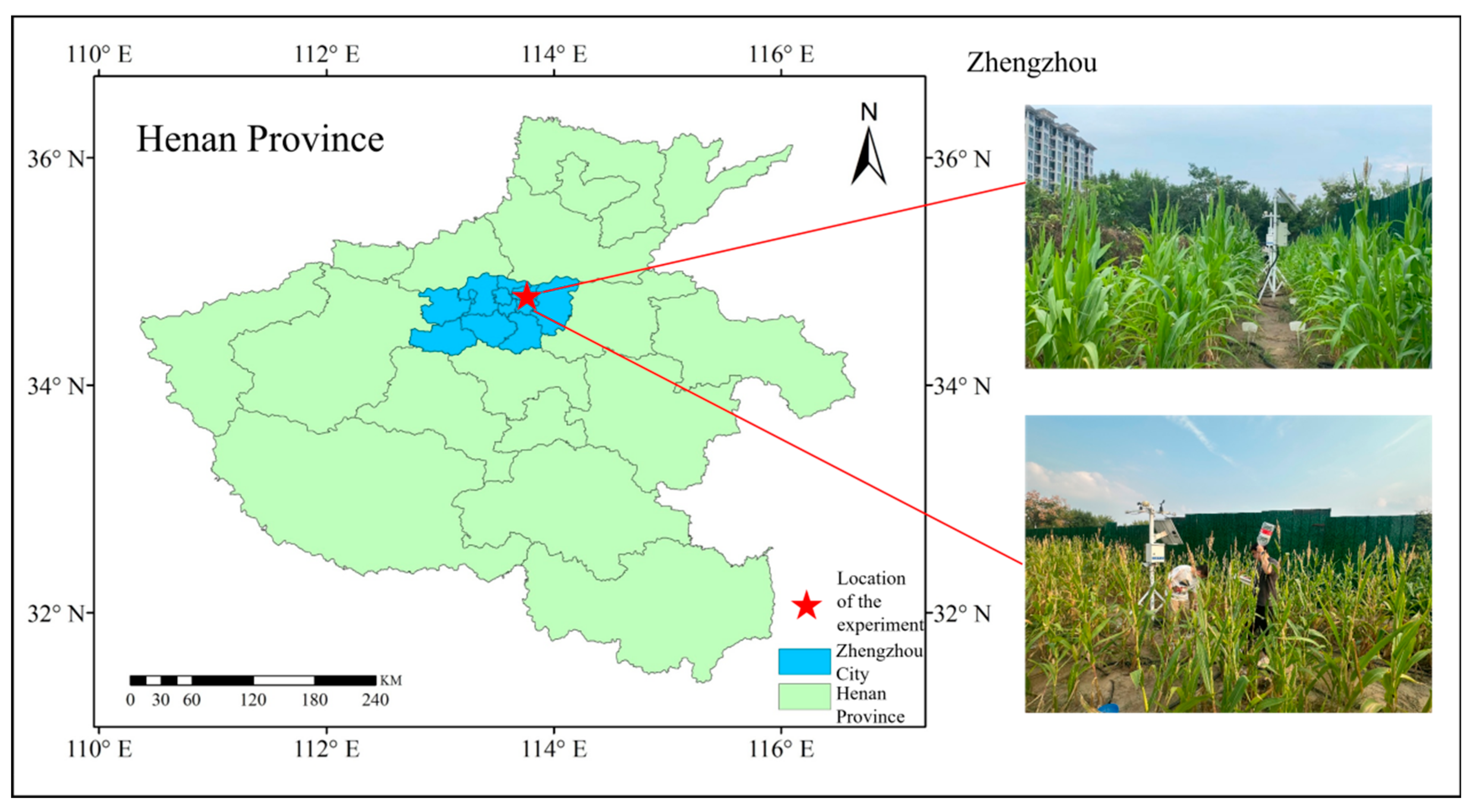

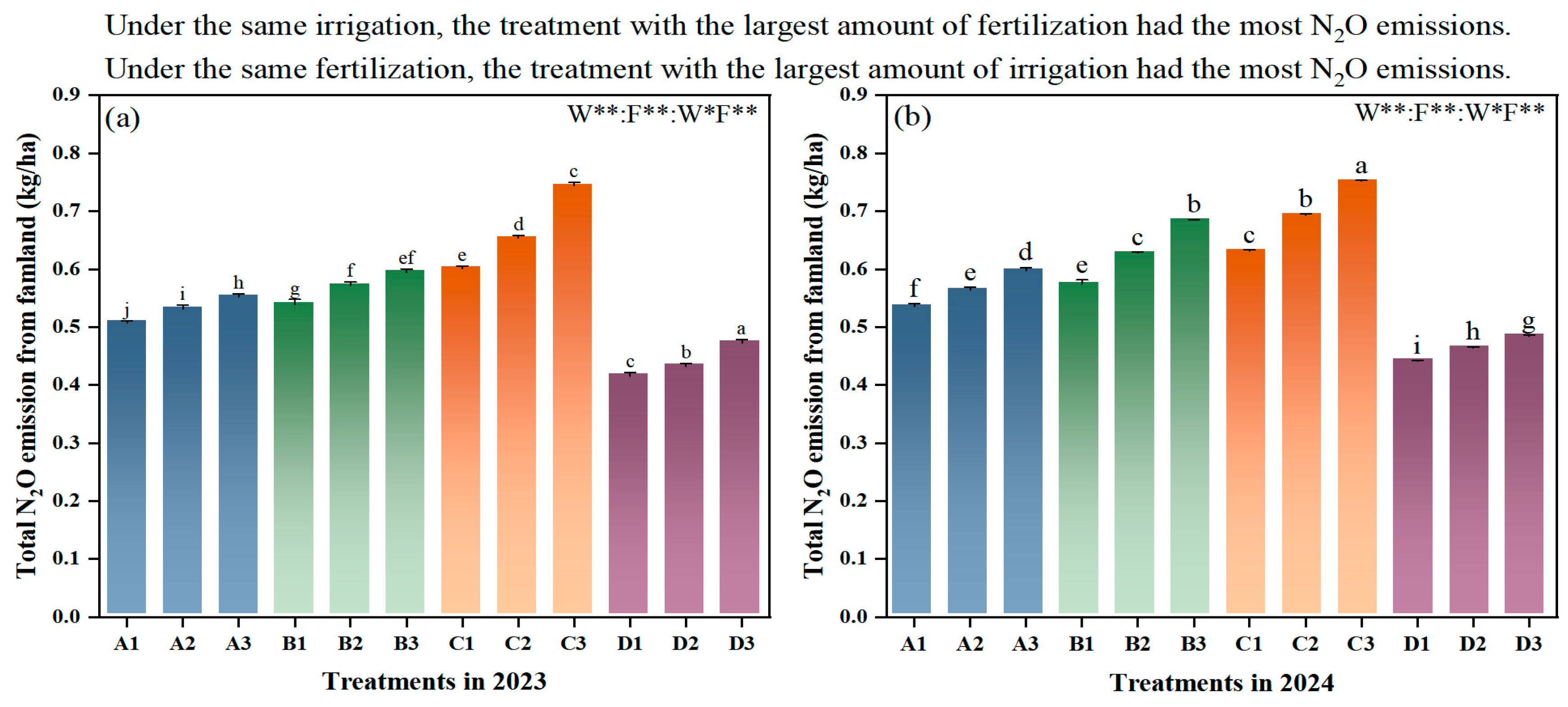

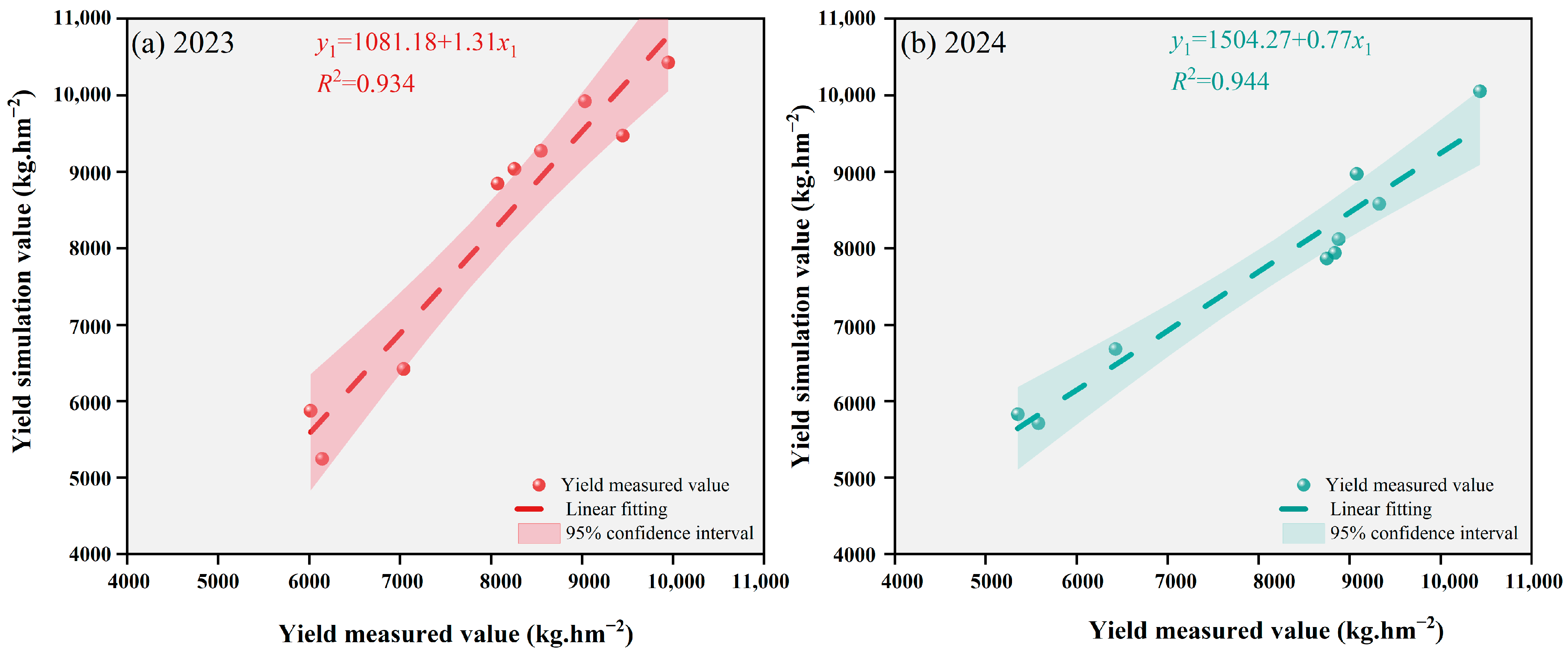
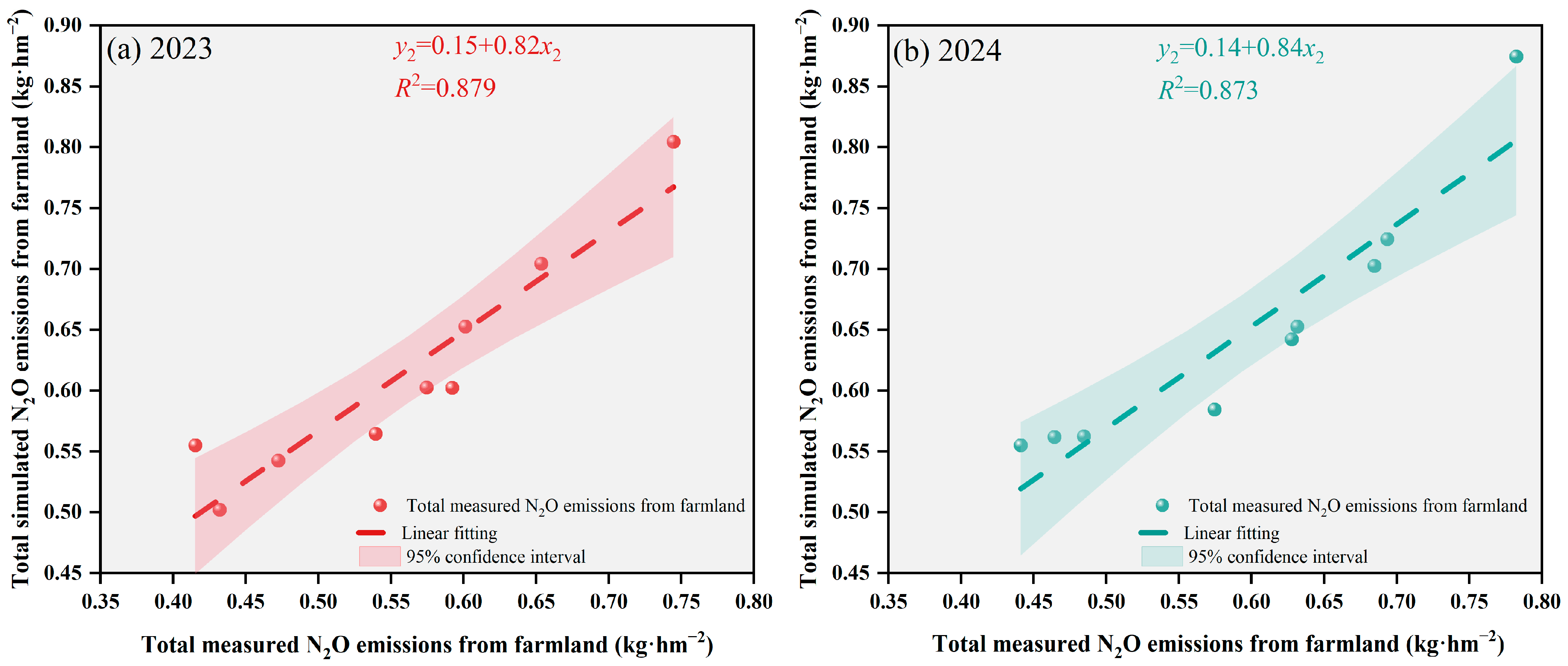

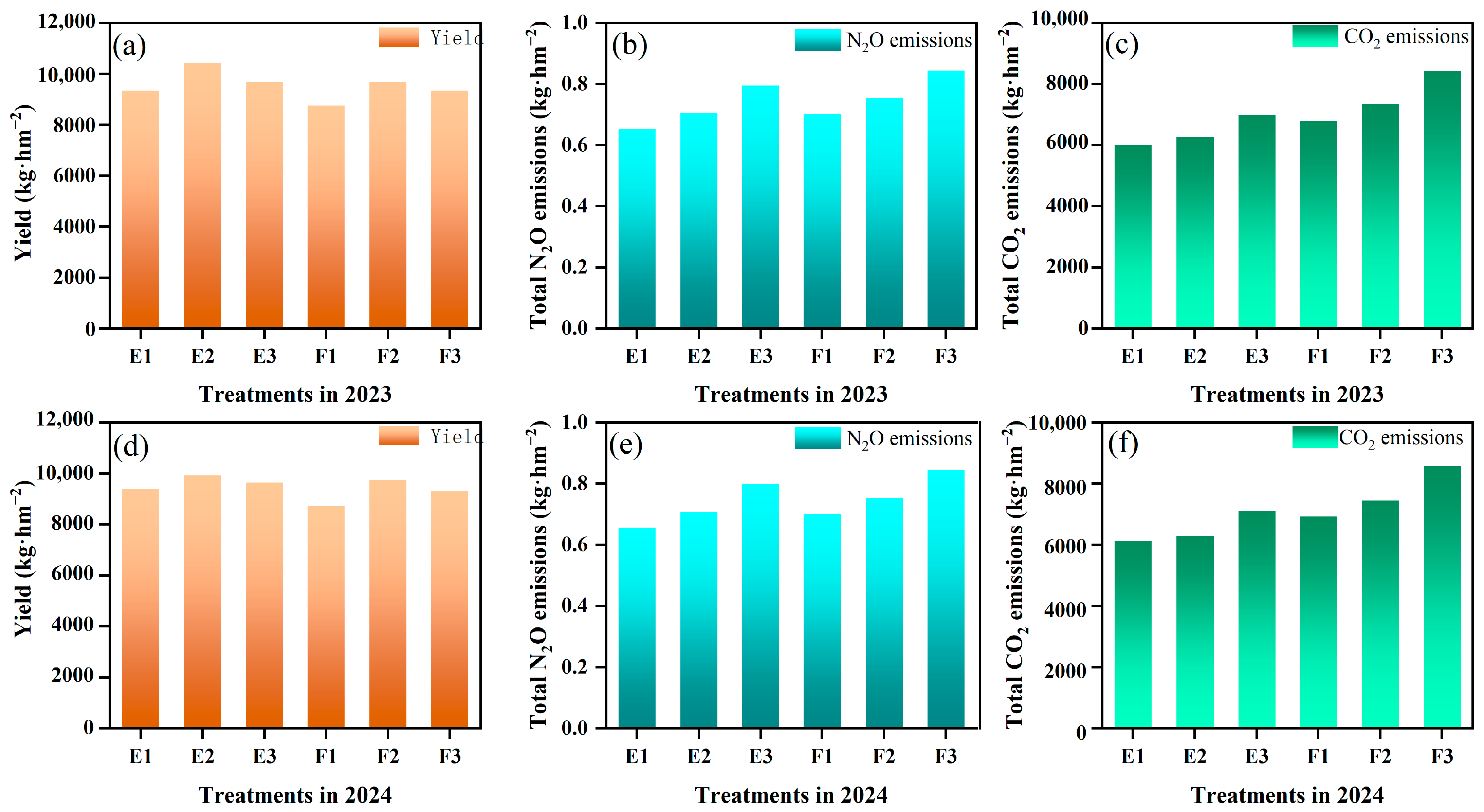
| Treatment | Irrigation Upper Limit | Irrigation Lower Limit | Fertilization (kg/ha) | Irrigation (m3/ha) |
|---|---|---|---|---|
| A1 | 90%θf | 60%θf | 540 | 800 |
| A2 | 450 | |||
| A3 | 360 | |||
| B1 | 70%θf | 540 | 1050 | |
| B2 | 450 | |||
| B3 | 360 | |||
| C1 | 80%θf | 540 | 1400 | |
| C2 | 450 | |||
| C3 | 360 | |||
| D1 | Rainfall | Rainfall | 540 | 0 |
| D2 | 450 | |||
| D3 | 360 |
| Growing Stage | Seedling—Jointing | Jointing—Heading | Heading—Filling | Grouting—Maturity |
|---|---|---|---|---|
| Irrigation lower limit | 60%θf | 65%θf | 70%θf | 60%θf |
| Irrigation upper limit | 90%θf | 90%θf | 90%θf | 90%θf |
| Crop Parameters | Unit | Summer Maize |
|---|---|---|
| Optimum output | kg C/ha | 4900 |
| Biomass allocation ratios | Grain/stem leaf/root | 0.53/0.36/0.07 |
| Total nitrogen requirement | kg N/ha | 116.905 |
| Accumulated temperature | °C | 1800 |
| Nitrogen fixation coefficient | 0.9 | |
| Optimum temperature | °C | 31 |
| Indicator | R2 | RMSE (kg/ha) | EF |
|---|---|---|---|
| 2023 | 0.934 | 664.027 | 0.746 |
| 2024 | 0.944 | 593.873 | 0.809 |
| Indicator | R2 | RMSE (kg/ha) | EF |
|---|---|---|---|
| 2023 | 0.879 | 0.066 | 0.564 |
| 2024 | 0.873 | 0.067 | 0.639 |
| Indicator | R2 | RMSE (kg/ha) | EF |
|---|---|---|---|
| 2023 | 0.828 | 561.232 | 0.818 |
| 2024 | 0.834 | 586.502 | 0.811 |
Disclaimer/Publisher’s Note: The statements, opinions and data contained in all publications are solely those of the individual author(s) and contributor(s) and not of MDPI and/or the editor(s). MDPI and/or the editor(s) disclaim responsibility for any injury to people or property resulting from any ideas, methods, instructions or products referred to in the content. |
© 2025 by the authors. Licensee MDPI, Basel, Switzerland. This article is an open access article distributed under the terms and conditions of the Creative Commons Attribution (CC BY) license (https://creativecommons.org/licenses/by/4.0/).
Share and Cite
Cui, B.; Liu, L.; Ma, J.; Zhao, Y.; Hao, X.; Ding, Y.; Chen, Y.; Han, J. Modeling the Effects of Different Water and Fertilizer Irrigation Systems on Greenhouse Gas Emissions Using the DNDC Model. Agronomy 2025, 15, 1951. https://doi.org/10.3390/agronomy15081951
Cui B, Liu L, Ma J, Zhao Y, Hao X, Ding Y, Chen Y, Han J. Modeling the Effects of Different Water and Fertilizer Irrigation Systems on Greenhouse Gas Emissions Using the DNDC Model. Agronomy. 2025; 15(8):1951. https://doi.org/10.3390/agronomy15081951
Chicago/Turabian StyleCui, Bifeng, Lansong Liu, Jianqin Ma, Yan Zhao, Xiuping Hao, Yu Ding, Yijian Chen, and Jiaqi Han. 2025. "Modeling the Effects of Different Water and Fertilizer Irrigation Systems on Greenhouse Gas Emissions Using the DNDC Model" Agronomy 15, no. 8: 1951. https://doi.org/10.3390/agronomy15081951
APA StyleCui, B., Liu, L., Ma, J., Zhao, Y., Hao, X., Ding, Y., Chen, Y., & Han, J. (2025). Modeling the Effects of Different Water and Fertilizer Irrigation Systems on Greenhouse Gas Emissions Using the DNDC Model. Agronomy, 15(8), 1951. https://doi.org/10.3390/agronomy15081951





